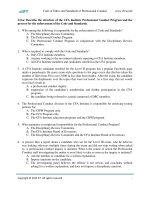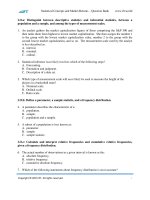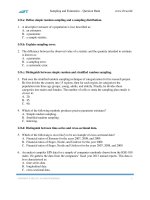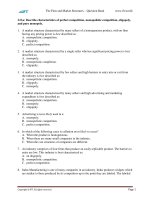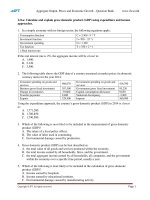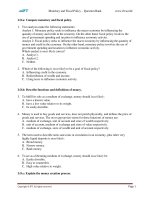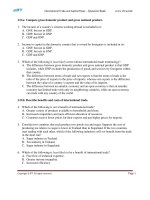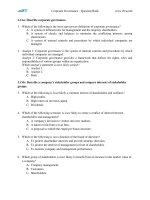CFA 2018 quest bank r42 portfolio risk and return part i q bank
Bạn đang xem bản rút gọn của tài liệu. Xem và tải ngay bản đầy đủ của tài liệu tại đây (320.47 KB, 11 trang )
Portfolio Risk and Return: Part I – Question Bank
www.ift.world
LO.a: Calculate and interpret major return measures and describe their appropriate uses.
1. Siraj intends to evaluate the annualized returns of his buy-and-hold strategy after making his
annual deposits to an account for each of the past three years. Which of the following
methods should be used, most appropriately?
A. Geometric mean return.
B. Money-weighted return.
C. Arithmetic mean return.
2. An investor's transactions in a mutual fund and the fund's return over a three year period are
given below:
Year 1 Year 2 Year 3
New investment at the beginning of the year $2,000 $2,200 $3,000
Investment return for the year
-10% 25%
40%
Withdrawal by investor at the end of the year $0
$1,000 $0
Based on the data, the money weighted return for the investor is closest to:
A. 51.8%.
B. 24.7%.
C. 74.9%.
3. An analyst observes that the historic geometric returns are 10% for fixed income securities,
5% for treasury bills and 2% for inflation. The real rate of return for fixed income securities
is closest to:
A. 4.7%.
B. 7.2%.
C. 7.8%.
4. An analyst obtains the following annual rates of return for a mutual fund:
Year
2011 2012 2013
Return (%) 23
-14
-1.5
The fund’s holding period return over the three-year period is closest to:
A. 4.19%.
B. 4.75%.
C. 5.29%.
5. Ahmed invested in a fund which offered the following returns over the last three years:
Year Assets under management at start of year Net Return (%)
1.
15 million
15
2.
20 million
-5
3.
5 million
10
The money-weighted annual return is closest to:
A. 4.5%.
B. 5.0%.
C. 12.1%.
Portfolio Risk and Return: Part I – Question Bank
www.ift.world
6. You are evaluating the performance of two investment managers in your team:
Soomro: In the last 200 days, he has earned a holding period return of 9.2 percent.
Seemi: Over the past 5 months, her holding period return is 6.0%.
Which manager performed better?
A. Soomro.
B. Seemi.
C. Both did equally well.
7. Saman purchases two shares of Sun Co, one for $32 at time t = 0 and the other for $45 at t =
1. At t = 2, he sells them both for $53 each. The stock paid a dividend of $0.75 per share at t
= 1 and at t = 2. The periodic money weighted rate of return on the investment is closest to:
A. 23.82%.
B. 25.76%.
C. 26.75%.
8. Liquidity least likely impacts which of the following with respect to trading costs?
A. stock price.
B. brokerage commissions.
C. bid–ask spread.
9. Fred David invested in the stock of a hypothetical company called Stars Ltd. He purchased
three shares worth $100 each at the beginning of the first year. He invested in another share
worth $115 before the beginning of the second year. He sold the four shares at the end of the
second year for a price of $120 per share. At the end of each period, the stock paid a dividend
of $2 per share. Which of the following is most likely to be the money-weighted rate of
return?
A. 8.76%.
B. 9.62%.
C. 10.66%.
LO.b: Describe characteristics of the major asset classes that investors consider in forming
portfolios.
10. Which of the following asset classes have historically had the highest returns and standard
deviation?
A. Long-term corporate bonds.
B. Large-cap stocks.
C. Small-cap stocks.
11. Which of the following asset classes have historically had the lowest returns and standard
deviation?
A. Long term treasury bonds.
B. Treasury bills.
C. Large cap stocks.
Portfolio Risk and Return: Part I – Question Bank
www.ift.world
LO.c: Calculate and interpret the mean, variance, and covariance (or correlation) of asset
returns based on historical data.
12. The following table presents historical information for two stocks, ABC and XYZ:
Variance of returns for ABC
0.0308
Variance of returns for XYZ
0.0705
Correlation coefficient between ABC and XYZ 0.6500
The covariance between ABC and XYZ is closest to:
A. 0.0014.
B. 0.0717.
C. 0.0303.
13. A measure of how the returns of two risky assets move in relation to each other is the:
A. portfolio return.
B. covariance.
C. standard deviation.
14. Ahmed’s portfolio consists of two stocks: Ivne. Ltd and Iris. Co. The standard deviation of
returns is 0.25 for Ivne. Ltd and 0.14 for Iris. Co. The covariance between the returns of the
two stocks is 0.0045. The correlation of returns between them is:
A. 0.008.
B. 0.129.
C. 7.778.
15. Which of the following statements is least accurate?
A. If you add a stock to a portfolio where the risk of the stock is equal to the risk of the
portfolio and the correlation is 0.6, the overall risk of the new portfolio will be lower.
B. The correlation coefficient and potential benefits from diversification are inversely
related.
C. A zero variance portfolio can be constructed by combining two securities with a
correlation coefficient of 0.
16. You are a U.S investor with 78% invested in the S&P 500 and 22% invested in the Dow
Jones 30 index. The risk and expected return data is given below:
S&P 500
Dow Jones 30
Risk (%)
16.32%
32.86%
Expected Return (%)
9.82
14.97
Covariance (% squared)
0.43
The portfolio’s expected return and risk are closest to:
A. 10.95% and 15.14%.
B. 10.90% and 15.10%.
C. 11.58% and 15.10%.
17. The correlation between the historical returns of Stock A and Stock B is 0.75. If the variance
of Stock A is 0.25 and the variance of Stock B is 0.36, the covariance of the returns of Stock
A and Stock B is closest to:
A. 0.225.
Portfolio Risk and Return: Part I – Question Bank
www.ift.world
B. 0.30.
C. 0.36.
LO.d: Explain risk aversion and its implications for portfolio selection.
18. An investment has a 50% probability of returning 10% and a 50% probability of returning
4%. An investor prefers this uncertain investment over a guaranteed return of 8%. This
preference most likely indicates that the investor is risk:
A. seeking.
B. neutral.
C. averse.
19. The risk-return relationship for a risk averse investor is most likely to be:
A. positive.
B. negative.
C. neutral.
20. You are advising three clients of whom Eliyahu Goldratt is the most risk-averse. According
to the utility theory, the indifference curve for Goldratt will most likely be the one with the:
A. greatest slope coefficient.
B. smallest intercept value.
C. least convexity.
21. Which of the following statements about risk-averse investors is least accurate? A risk-averse
investor:
A. will take additional investment risk if sufficiently compensated for this risk.
B. seeks out the investment with minimum risk, given a certain level of return.
C. avoids participating in global equity markets.
LO.e: Calculate and interpret portfolio standard deviation.
22. Selected information about shares of two companies is provided below:
ABC Corporation XYZ Corporation
Standard deviation
25%
30%
Correlation of returns 0.24
Portfolio weights
40%
60%
The standard deviation of returns of the portfolio formed with these two stocks is closest to:
A. 0.0043.
B. 0.2259.
C. 0.0756.
23. An analyst studies an investment portfolio with stocks of Company ABC and Company JKL.
He wishes to compute the correlation of returns between the stocks. However, the only bits
of information available include the following data.
Stock Standard Deviation Portfolio Weights
ABC
36%
40%
Portfolio Risk and Return: Part I – Question Bank
www.ift.world
JKL
27%
60%
The standard deviation of the returns for the portfolio is 30%. The correlation coefficient for
the returns is closest to:
A. 0.92.
B. 1.02.
C. 1.84.
24. The following data is available:
Expected Return Standard Deviation Risk aversion coefficient
15%
27%
4
The utility of this investment is closest to:
A. 0.0040.
B. 0.0041.
C. 0.0042.
25. If the correlation between Stock A and Stock B in a two-asset portfolio increases during a
market decline, with a constant weightage of the assets and expected standard deviations of
each, the portfolio’s volatility will:
A. increase.
B. stay constant.
C. decrease.
26. Arman is considering investing in a small-cap stock fund and a general bond fund. The
correlation between the two fund returns is 0.12. Expected annual return equaled 16% and
6% respectively with standard deviation of 30% for small-cap stock and 11.5% for general
bond fund. If Arman requires a portfolio return of 10 percent, the proportions in each fund
respectively should be closest to:
A. 30% and 70%.
B. 36.4% and 63.4%.
C. 40% and 60%.
27. Information about a portfolio that consist of two assets is provided below:
Asset Portfolio Weight
Standard deviation
ABC
30%
10%
JKL
70%
8%
If the correlation coefficient between the two assets is 0.8, the standard deviation of the
portfolio is closest to:
A. 8.2%.
B. 9.8%.
C. 9.1%.
LO.f: Describe the effect on a portfolio’s risk of investing in assets that are less than
perfectly correlated.
Portfolio Risk and Return: Part I – Question Bank
www.ift.world
28. Assume that two securities that are present in equal proportions in an investor’s portfolio
have the same expected returns and volatility. For which of the following correlations
between the two securities would the investor most likely be able to achieve the greatest
diversification benefit?
A. +0.86.
B. -0.86.
C. 0.00.
29. A correlation matrix of the returns for securities A, B, and C is reported below:
B
C
Security A
A
1.0
B
-1.0 1.0
C
0.5 -0.5 1.0
Assuming that the expected return and the standard deviation of each security are the same, a
portfolio consisting of an equal allocation of which two securities will be most effective for
portfolio diversification? Securities:
A. A and B.
B. A and C.
C. B and C.
30. A portfolio contains equal weights of two securities that have the same standard deviation. If
the correlation between the returns of the two securities was to increase, the portfolio risk
would most likely:
A. increase.
B. remain the same.
C. decrease.
LO.g: Describe and interpret the minimum-variance and efficient frontiers of risky assets
and the global minimum-variance portfolio.
31. The set of risky portfolio that give the highest return at each level of risk will most likely lie
on the:
A. capital allocation line.
B. efficient frontier.
C. security market line.
32. The capital allocation line (CAL) dominates the efficient frontier because of the ability of the
investor to:
A. invest in the risk-free asset.
B. invest in market portfolio.
C. invest in a zero-beta asset.
33. Which of the following in combination with the risk-free asset forms the dominant capital
allocation line?
A. global minimum-variance portfolio.
Portfolio Risk and Return: Part I – Question Bank
www.ift.world
B. optimal risky portfolio.
C. levered portfolio of risky assets.
34. Which of the following portfolios will most likely lie at the point of tangency between the
capital allocation line and the efficient frontier of risky assets?
A. Optimal investor portfolio.
B. Global minimum variance portfolio.
C. Optimal risky portfolio.
LO.h: Discuss the selection of an optimal portfolio, given an investor’s utility (or risk
aversion) and the capital allocation line.
35. Relative to an investor with steep upward sloping indifference curves, an investor with a less
steep indifference curve most likely has:
A. a higher level of risk aversion.
B. a lower level of risk aversion.
C. the same level of risk aversion.
36. Investor X has a higher risk aversion than investor Y. On the capital allocation line, will
investor Y's optimal portfolio have a higher expected return?
A. Yes.
B. No, since investor Y has low risk tolerance.
C. No, since investor Y has high risk tolerance.
37. The optimal portfolio, as suggested by the mean–variance theory, is determined by every
individual investor’s:
A. borrowing rate.
B. risk-free rate.
C. risk preference.
Portfolio Risk and Return: Part I – Question Bank
www.ift.world
Solutions
1. A is correct. The geometric mean return compounds the returns instead of the amount
invested.
2. B is correct.
Year 1
0
2,000
2,000
-10%
-200
0
1,800
Year 2
1,800
2,200
4,000
25%
1,000
1,000
4,000
Year 3
4,000
3,000
7,000
40%
2,800
0
9,800
Starting balance ($)
New investment at the beginning of the year ($)
Net balance at the beginning of the year ($)
Investment return for the year
Investment gain/loss ($)
Withdrawal by investor at the end of the year ($)
Balance at the end of the year ($)
CF0 = -2,000
CF1 = -2,200 (new investment at the beginning of year 2)
CF2 = -2,000 (withdrawal of 1,000 at the end of year 2, -3,000 new investment at the
beginning of year 3)
CF3 = 9,800 (balance at the end of year 3)
The money weighted return can be calculated as:
CF0 = -2,000, CF1 = -2,200, CF2 = -2,000, CF3 = 9,800, CPT IRR.
IRR = 24.74%.
3. C is correct. Real rate of return =
- 1 = 7.8%
4. A is correct. [(1 + 0.23) (1 − 0.14) (1 − 0.015)] – 1 = 0.0419 = 4.19%.
5. A is correct. All amounts are in million dollars. The table below shows the computation for
cashflows at the start of every year:
Year
Balance from previous year
New investment at the start of the
year (inflow)
Withdrawal at the start of the year
(outflow)
Net balance at the beginning of year
(given in the question)
Investment return for the year (given
in the question)
Investment gain (loss)
Balance at the end of year
1
0
15
2
17.25
2.75
3
19
0
0
0
14
15
20
5
15%
-5%
10%
2.25
17.25
-1
19
0.5
5.5
In order to calculate the money-weighted return (IRR) we assume the final amount (5.5) is
withdrawn. The money-weighted return is the IRR, which can be calculated using a financial
calculator as follows:
Portfolio Risk and Return: Part I – Question Bank
www.ift.world
CF0 = -15, CF1 = -2.75, CF2 = 14, CF3 = 5.5, CPT IRR.
IRR = 4.52%.
6. A is correct.
Annualized return for Soomro =
Annualized return for Seemi =
–
–
7. C is correct. The money-weighted return (IRR) can be computed using a financial calculator:
CF0 = -32; CF1 = -44.25; CF2 = 107.5; CPT IRR. IRR = 26.75%.
8. B is correct. Brokerage commissions are negotiated with the brokerage firm. A security’s
liquidity impacts the operational efficiency of trading costs.
9. C is correct.
Step 1:
Calculate the cash inflows and outflows at t = 0, 1 and 2.
At t = 0, Fred purchased 3 shares worth $100 each resulting in an outflow of $300
At t = 1, Fred purchased 1 share worth $ 115 and thus an outflow of $115.
Fred also received dividends worth $6 on the shares purchased earlier and thus an inflow of
$6.
Net cash outflow of $109
At t = 3, Fred sold 4 shares for worth $120 each therefore an inflow of $480.
Fred also received dividends worth $8 resulting in a net cash inflow of $488.
Step 2:
Given the following Net Cash flows, calculate the IRR which is equivalent to the moneyweighted return.
CF0 = -300, CF1 = -109 and CF2 = 488.
IRR or money weighted rate of return = 10.66%.
10. C is correct. Small-cap stocks have had the highest annual return and standard deviation of
return over time. Large-cap stocks and bonds have historically had lower risk and return than
small-cap stocks.
11. B is correct. Treasury bills have had the lowest annual return and standard deviation of return
over time.
12. C is correct.
=√
= 0.0303
13. B is correct. The covariance is defined as the co-movement of the returns of two assets or
how well the returns of two risky assets move together. Range and standard deviation are
measures of dispersion and measure risk, not how assets move together.
14. B is correct.
= 0.129.
Portfolio Risk and Return: Part I – Question Bank
www.ift.world
15. C is correct. A zero-variance portfolio can only be constructed if the correlation coefficient
between assets is -1.
16. A is correct.
Portfolio return = (0.78 * 0.0982) + (0.22 * 0.1497) = 0.1095 = 10.95%.
Portfolio risk = [w12σ12 + w22σ22+ 2w1w2Cov (R1, R2)] ½
= [(0.782 * 0.16322) + (0.222 * 0.32862) + (2 * 0.78 * 0.22 * 0.0043)] ½ = (0.02291) ½
= 15.14%.
=√
17. A is correct.
= 0.225
18. A is correct. A risk seeking investor prefers more risk to less risk. In the above example, he
prefers the investment with an expected return of (0.5)10 + (0.5)4 = 7% over a guaranteed
return of 8%.
19. A is correct. Historical data over long periods of time indicate that there exists a positive
risk–return relationship, which is a reflection of an investor’s risk aversion.
20. A is correct. The most risk-averse investor has the indifference curve with the greatest slope.
21. C is correct. Risk-averse investors are generally willing to invest in risky investments, if the
return on the investment is sufficient to reward the investor for taking on this risk.
Participants in securities markets are generally assumed to be risk-averse investors.
22. B is correct. Portfolio standard deviation =
√
23. A is correct. The standard deviation of the returns for a portfolio is given by:
√
√
Solve the equation to deduce the unknown i.e.
.
24. C is correct.
–
U = 0.15 – 0.5 * 4 * 0.272 = 0.0042.
25. A is correct. Higher correlations will result in a lower diversification benefit and higher
volatility.
26. C is correct.
( –
( –
)
)
;
Portfolio Risk and Return: Part I – Question Bank
www.ift.world
Thus, 40 percent should be invested in the small-cap fund and 60 percent should be invested
in the bond fund.
27. A is correct. Portfolio standard deviation =
√
.
28. B is correct. Diversification benefit is greatest when a portfolio consists of securities that do
not move together and thus the investor should invest in securities with the lowest correlation
i.e. – 0.86.
29. A is correct. The negative correlation of –1.0 between investment instruments A and B is
lowest and therefore is most effective for portfolio diversification.
30. A is correct. The standard deviation of the portfolio is directly proportional to the correlation
of assets within the portfolio.
31. B is correct. The efficient frontier is the part of the minimum variance frontier which
represents the set of portfolios that will give the highest return at each risk level.
32. A is correct. With the efficient frontier we are only allowed to invest in risky assets. With the
CAL this constraint is relaxed and we are also allowed to invest in the risk-free asset.
33. B is correct. The use of leverage and the combination of a risk-free asset and the optimal
risky asset will dominate the efficient frontier of risky assets (the Markowitz efficient
frontier).
34. C is correct. The optimal risky portfolio lies at the point of tangency between the capital
allocation line and the efficient frontier of risky assets.
35. B is correct. An investor with less steep indifference curves has a lower level of risk
aversion.
36. A is correct. Investor Y has a low risk aversion coefficient, therefore a high risk tolerance
and a higher expected return on the capital allocation line.
37. C is correct. Each individual investor’s optimal mix of the risk-free asset and the optimal
risky asset is determined by the investor’s risk preference.

